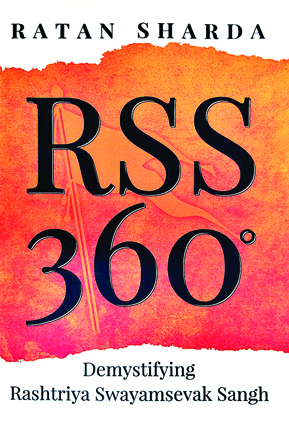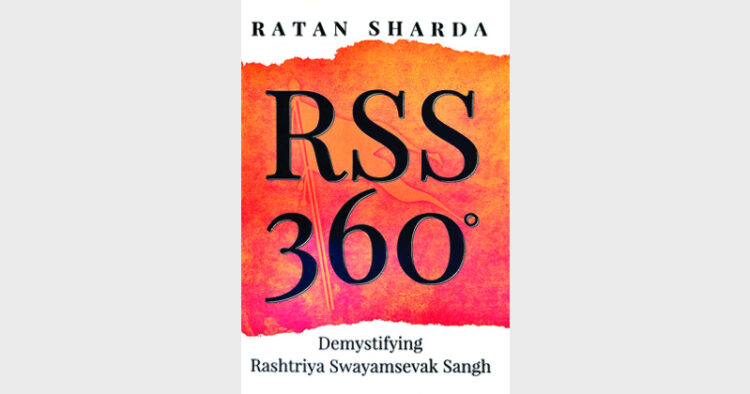RSS 360° draws a coast-to-coast picture of the Sangh. It is the book to pick if you have a question, ‘What is RSS?’ in mind
RSS 360° Demystifying Rashtriya Swayamsevak Sangh; Ratan Sharda; Bloomsbury (Paperback); Pp 299, 2018; Rs 499
One of the unexpected fallouts of Modi’s rise to power was the growing curiosity about an organisation that he attributed his character, courage and conviction to – The Rashtriya Swayamsevak Sangh (RSS). Though the organisation pre-dates independence, its name appeared in public domain during some of the most debilitating human and man-made calamities that this country has faced, for the manner in which its countless unsung heroes, its voluntary workers, Swayamsevaks, silently and sincerely rendered yeoman’s service in the most testing times.
Be it the 1975 Emergency imposed by Indira Gandhi or the killer floods and earthquakes that rocked this nation from time to time, RSS was always there – in service of the Nation and its fellow brethren. It was, however, the 2014 elections and the rise of one of its mentee, Modi, to national and international fame that sparked a larger interest in Sangh. The policies and practices of Modi, steeped in national pride, personal discipline and professional excellence that had tongues wagging about the organisation like never before. Reams have been doled out about the man and the organisation he claimed his allegiance to that openly and unabashedly espoused the mission of ‘nation-building’ as its raison d”etre.
Researching and Searching RSS
Growing interest lead to greater search and research, that led to startling revelations like RSS being the world’s largest voluntary organisation – a fact that shocked everyone. Here was an organisation that never sought any media attention and that never craved for power or position of any kind. Sangh was happy working quietly and consistently with the common man at grassroots level – something unheard of and alien in this power and publicity hungry world of today. The new found glory of the RSS for its long years of tireless hard work and perseverance became the cynosure of envy and angst by vested interests, which left no stone unturned to taint the organisation with malicious rumours.
The aim of RSS 360° Demystifying Rashtriya Swayamsevak Sangh is to lift the veil of ignorance and misinformation about RSS
The strength of the organisation like Shakha (local branch and activity centre) and Pracharak (dedicated battalion of highly qualified celibates who dedicate their life to the cause of the Nation and become exemplars for the society through their austere and highly principled life) practices, are ridiculed and shown in bad light. In short, RSS’s goodness and deliberate attempt to keep away from the limelight became its biggest bane.
This was hurting the feelings of many swayamsevaks, supporters and sympathisers of RSS, who knew the organisation and its commendable work. They felt it was high time to place this work in public domain for an honest and objective scrutiny by all and sundry rather than a twisted tale by vested groups. With the passage of time, there emerged a growing class of people, especially the youth, who genuinely believed that RSS was doing a great job and wished to partake in it but didn’t know how to go about it. Now, RSS saw a genuine reason to publicise and propagate its work. Afterall, instilling the spirit of patriotism amongst the future generation is an integral part of its nationalist agenda. This is where Ratan Sharda ji and his effort have come in.
Lifting the Veil of Ignorance
The aim of RSS 360° Demystifying Rashtriya Swayamsevak Sangh is to lift the veil of ignorance and misinformation about RSS. Who could do this better than the author Ratan Sharda ji, who hails from a family of dedicated swayamsevaks and karyakartas and someone who has grown into the organisation and held various roles, responsibilities and positions throughout his life? Infact, such seamless is his understanding of the organisation, its ideology, culture, structure and sensibilities that he has internalised it and made it an inseparable part of his existence. As a result he dons many hats effortlessly, one being that of a much sought after TV commentator on national issues.
RSS 360° does exactly what it states to do – it demystifies the RSS like never before, in a simple, easy-to-read and comprehensive manner, thereby providing a wholistic understanding about RSS to the uninitiated. Even for those who know the organisation in various degrees, it is an interesting and enlightening read with many insightful details, anecdotes, precedents and practices that will add depth to one’s existing knowledge and understanding and provide a ready reckoner of facts and reference points about RSS. All chapters are well thought of and meticulously written covering a wide range of issues that are important and of interest to general public. The book does not shy away to touch upon, in sufficient details, controversial topics like India’s common culture & ancestry, misfit of Anglo-Saxon concepts like secularism, treatment of minority, Shakha as a symbol of discipline and team work, the essence of Hindutva and its centrality in nation building, to mention a few.
This book has two discerning distinctions, giving it a visible detour from all previous works of this genre. Firstly, it is written by a proud Sanghi who is not afraid of overtly proclaiming his ideological moorings. It is about Sangh and yet it is happily published by a non-Sanghi publishing house. Yes, Bloombury is an independent, international publishing house with centres across the globe, including New Delhi, India. Needless to say, it has no rightist leaning even in a remote fashion. And secondly, the Foreword is penned by none other than Madhu Kishwar ji, an acclaimed intellectual belonging to the ‘leftist cabal’ once upon a time. Despite her palpable fear of being branded as a ‘Sanghi’, she did a fine job by showing reverence where due and being critical where needed. In fact, her key criticism of Sangh not being media-savvy and giving a befitting reply to its detractors, also displays her underlying admiration for the organisation. Her elaborate foreword, ironically but aptly, provides the 360th degree to the book. Life has come full circle.
All in all, RSS 360° will be remembered as an organisational biography with a welcome twist. Its simple layman’s language, sans puritan Hindi and Sanskrit, makes it an easy read and its light hearted anecdotal/experiential style, makes it an interesting read. The best part is that it is a well-balanced and objective rendition of an insider, a rather rare feat to achieve, for which the author needs to be lauded. To conclude, it can be stated with conviction that RSS 360° is sure to become a staple read, rather reasonable starting point, for anyone who wants to know RSS now and in the times to come.
(The reviewer is a visiting faculty at Gautam Buddha University & Director J&K Study Centre)
















Comments